University Report: Work Environment and Employee Wellbeing Analysis
VerifiedAdded on 2022/08/15
|15
|3178
|11
Report
AI Summary
This report examines the crucial relationship between the work environment and employee wellbeing, a topic of paramount importance for organizational success. It delves into the factors that contribute to a healthy and supportive workplace, including physical conditions, emotional support, and work-life balance. The study investigates how these elements influence employee retention, productivity, and overall job satisfaction. The report explores various theories, such as Lewin’s Field Theory and the Well-Being Theory, to provide a comprehensive understanding of the subject. Furthermore, the research utilizes secondary data collection methods, including journal articles and existing research, to support its findings. The report addresses potential ethical considerations and presents a clear research methodology, including data analysis techniques. Ultimately, the report aims to identify effective strategies for improving the work environment and, consequently, enhancing employee wellbeing. This detailed analysis provides valuable insights for businesses seeking to create a thriving and productive workplace.
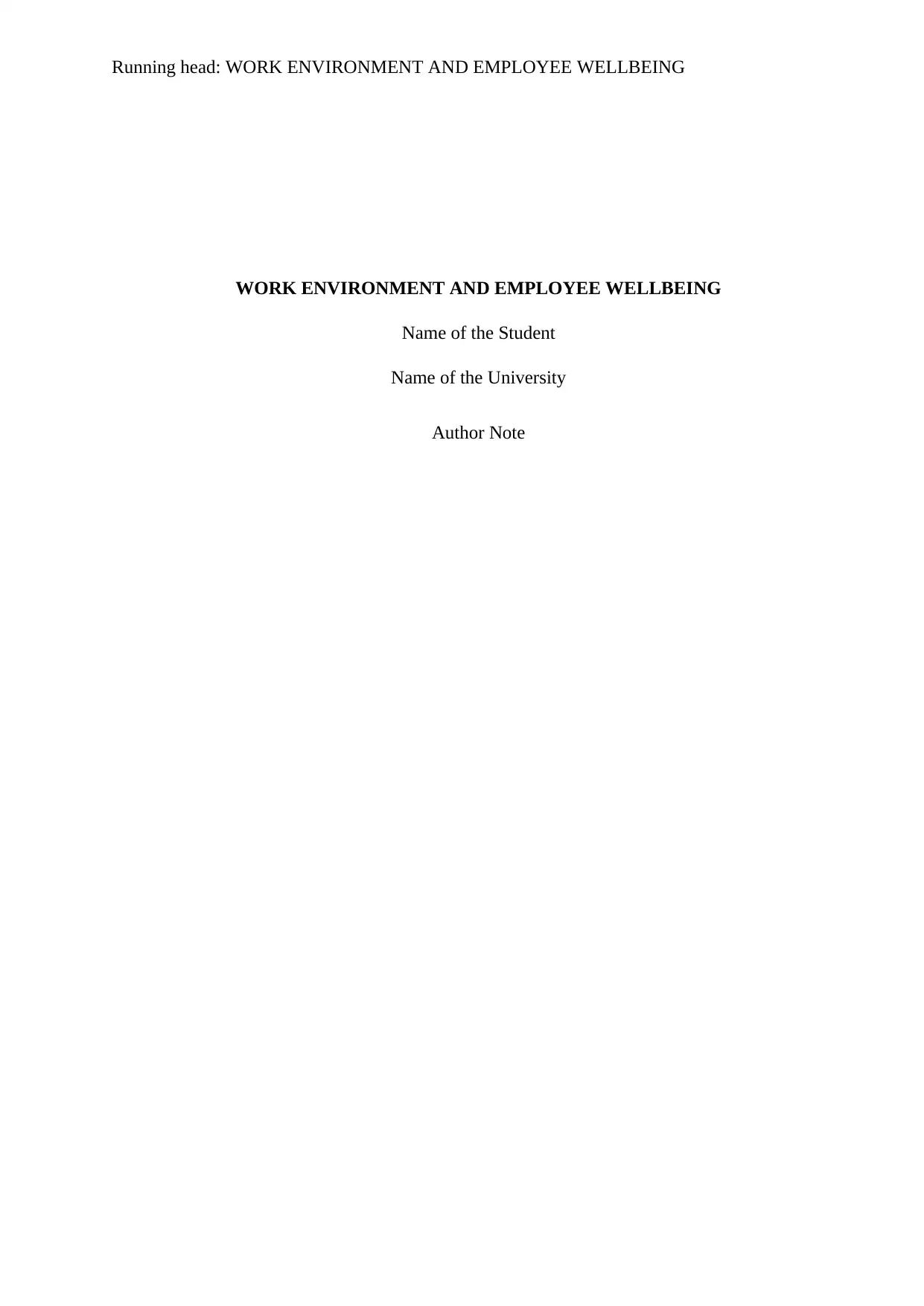
Running head: WORK ENVIRONMENT AND EMPLOYEE WELLBEING
WORK ENVIRONMENT AND EMPLOYEE WELLBEING
Name of the Student
Name of the University
Author Note
WORK ENVIRONMENT AND EMPLOYEE WELLBEING
Name of the Student
Name of the University
Author Note
Paraphrase This Document
Need a fresh take? Get an instant paraphrase of this document with our AI Paraphraser
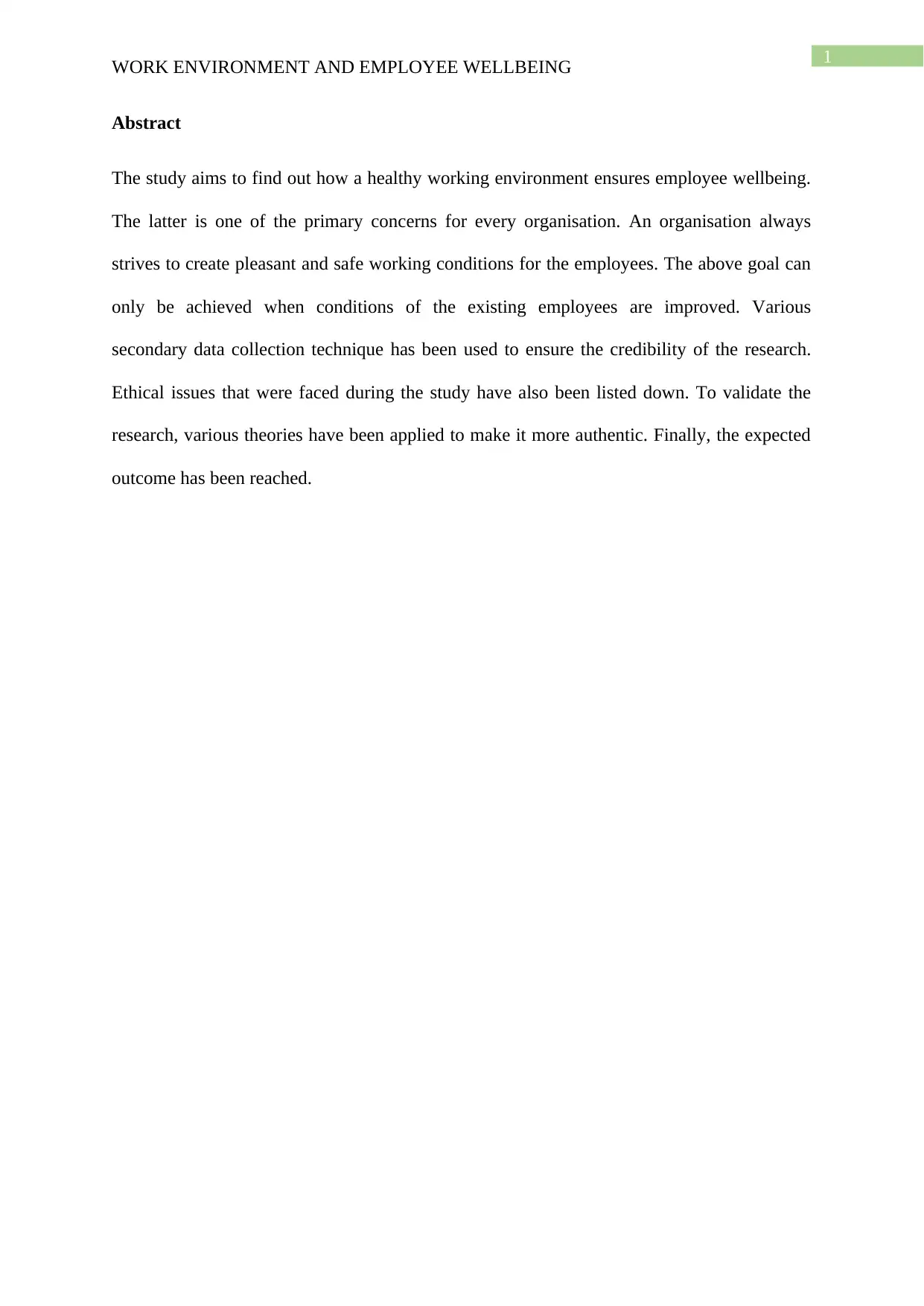
1
WORK ENVIRONMENT AND EMPLOYEE WELLBEING
Abstract
The study aims to find out how a healthy working environment ensures employee wellbeing.
The latter is one of the primary concerns for every organisation. An organisation always
strives to create pleasant and safe working conditions for the employees. The above goal can
only be achieved when conditions of the existing employees are improved. Various
secondary data collection technique has been used to ensure the credibility of the research.
Ethical issues that were faced during the study have also been listed down. To validate the
research, various theories have been applied to make it more authentic. Finally, the expected
outcome has been reached.
WORK ENVIRONMENT AND EMPLOYEE WELLBEING
Abstract
The study aims to find out how a healthy working environment ensures employee wellbeing.
The latter is one of the primary concerns for every organisation. An organisation always
strives to create pleasant and safe working conditions for the employees. The above goal can
only be achieved when conditions of the existing employees are improved. Various
secondary data collection technique has been used to ensure the credibility of the research.
Ethical issues that were faced during the study have also been listed down. To validate the
research, various theories have been applied to make it more authentic. Finally, the expected
outcome has been reached.
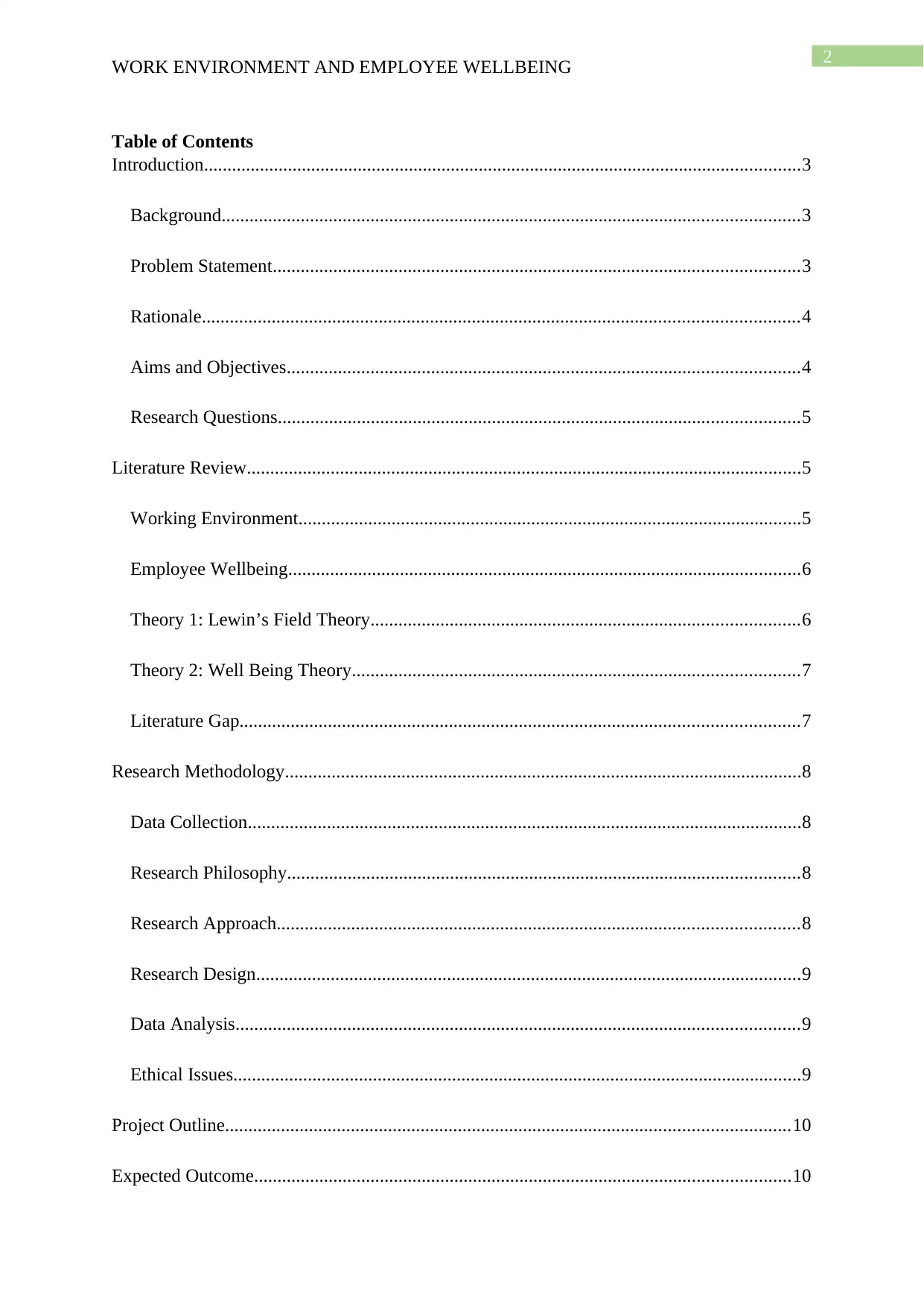
2
WORK ENVIRONMENT AND EMPLOYEE WELLBEING
Table of Contents
Introduction................................................................................................................................3
Background............................................................................................................................3
Problem Statement.................................................................................................................3
Rationale................................................................................................................................4
Aims and Objectives..............................................................................................................4
Research Questions................................................................................................................5
Literature Review.......................................................................................................................5
Working Environment............................................................................................................5
Employee Wellbeing..............................................................................................................6
Theory 1: Lewin’s Field Theory............................................................................................6
Theory 2: Well Being Theory................................................................................................7
Literature Gap........................................................................................................................7
Research Methodology...............................................................................................................8
Data Collection.......................................................................................................................8
Research Philosophy..............................................................................................................8
Research Approach................................................................................................................8
Research Design.....................................................................................................................9
Data Analysis.........................................................................................................................9
Ethical Issues..........................................................................................................................9
Project Outline.........................................................................................................................10
Expected Outcome...................................................................................................................10
WORK ENVIRONMENT AND EMPLOYEE WELLBEING
Table of Contents
Introduction................................................................................................................................3
Background............................................................................................................................3
Problem Statement.................................................................................................................3
Rationale................................................................................................................................4
Aims and Objectives..............................................................................................................4
Research Questions................................................................................................................5
Literature Review.......................................................................................................................5
Working Environment............................................................................................................5
Employee Wellbeing..............................................................................................................6
Theory 1: Lewin’s Field Theory............................................................................................6
Theory 2: Well Being Theory................................................................................................7
Literature Gap........................................................................................................................7
Research Methodology...............................................................................................................8
Data Collection.......................................................................................................................8
Research Philosophy..............................................................................................................8
Research Approach................................................................................................................8
Research Design.....................................................................................................................9
Data Analysis.........................................................................................................................9
Ethical Issues..........................................................................................................................9
Project Outline.........................................................................................................................10
Expected Outcome...................................................................................................................10
⊘ This is a preview!⊘
Do you want full access?
Subscribe today to unlock all pages.

Trusted by 1+ million students worldwide
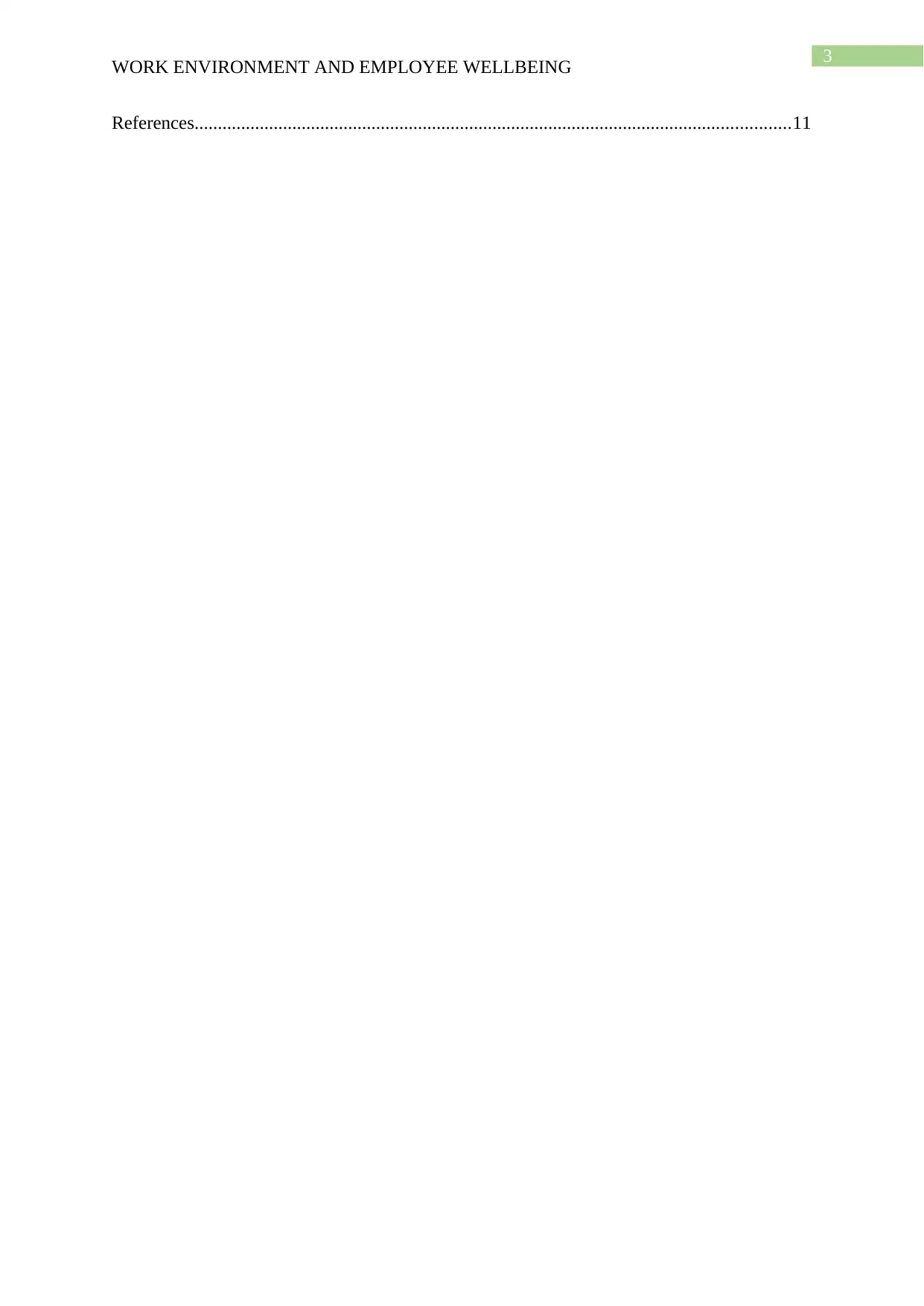
3
WORK ENVIRONMENT AND EMPLOYEE WELLBEING
References................................................................................................................................11
WORK ENVIRONMENT AND EMPLOYEE WELLBEING
References................................................................................................................................11
Paraphrase This Document
Need a fresh take? Get an instant paraphrase of this document with our AI Paraphraser
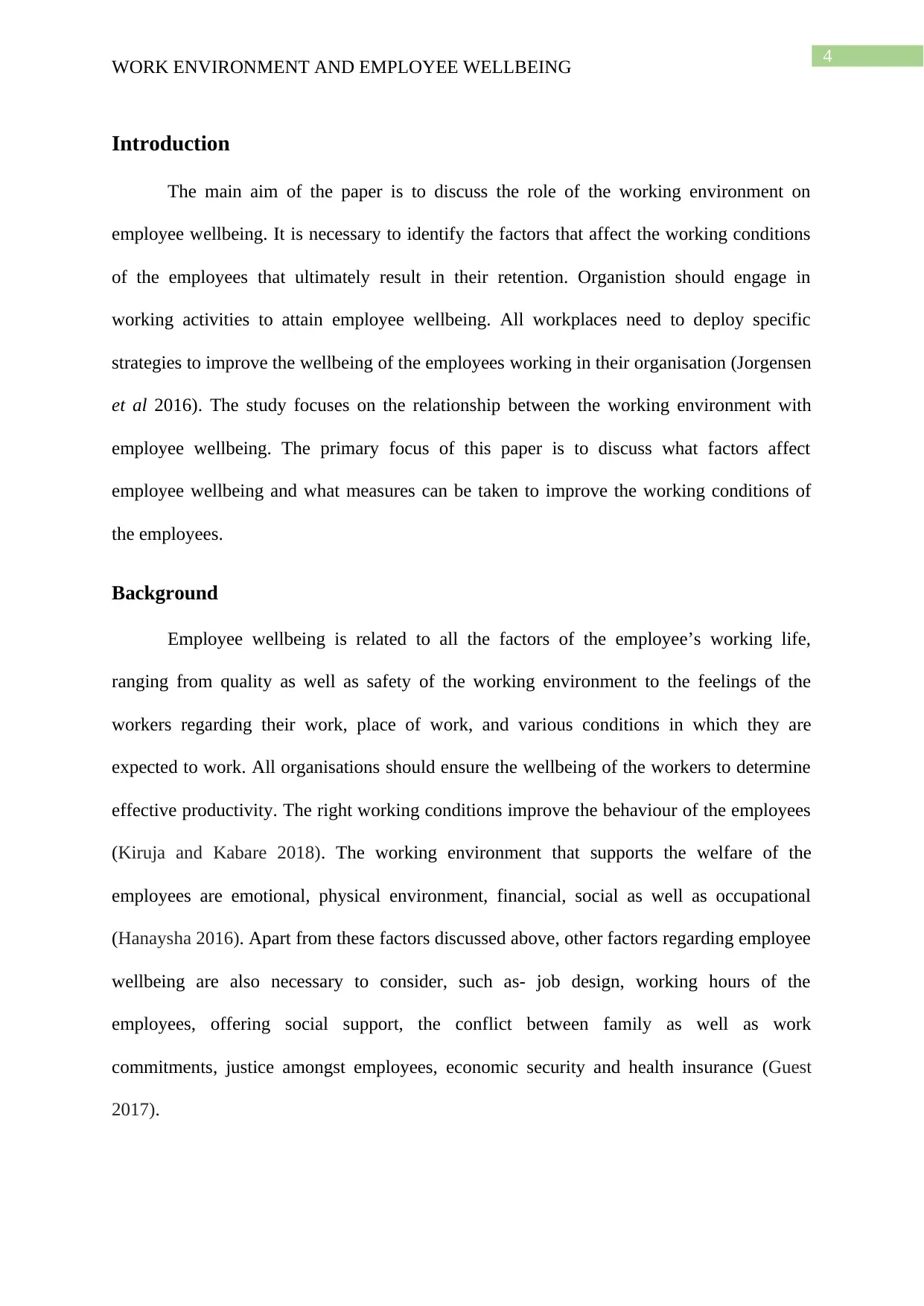
4
WORK ENVIRONMENT AND EMPLOYEE WELLBEING
Introduction
The main aim of the paper is to discuss the role of the working environment on
employee wellbeing. It is necessary to identify the factors that affect the working conditions
of the employees that ultimately result in their retention. Organistion should engage in
working activities to attain employee wellbeing. All workplaces need to deploy specific
strategies to improve the wellbeing of the employees working in their organisation (Jorgensen
et al 2016). The study focuses on the relationship between the working environment with
employee wellbeing. The primary focus of this paper is to discuss what factors affect
employee wellbeing and what measures can be taken to improve the working conditions of
the employees.
Background
Employee wellbeing is related to all the factors of the employee’s working life,
ranging from quality as well as safety of the working environment to the feelings of the
workers regarding their work, place of work, and various conditions in which they are
expected to work. All organisations should ensure the wellbeing of the workers to determine
effective productivity. The right working conditions improve the behaviour of the employees
(Kiruja and Kabare 2018). The working environment that supports the welfare of the
employees are emotional, physical environment, financial, social as well as occupational
(Hanaysha 2016). Apart from these factors discussed above, other factors regarding employee
wellbeing are also necessary to consider, such as- job design, working hours of the
employees, offering social support, the conflict between family as well as work
commitments, justice amongst employees, economic security and health insurance (Guest
2017).
WORK ENVIRONMENT AND EMPLOYEE WELLBEING
Introduction
The main aim of the paper is to discuss the role of the working environment on
employee wellbeing. It is necessary to identify the factors that affect the working conditions
of the employees that ultimately result in their retention. Organistion should engage in
working activities to attain employee wellbeing. All workplaces need to deploy specific
strategies to improve the wellbeing of the employees working in their organisation (Jorgensen
et al 2016). The study focuses on the relationship between the working environment with
employee wellbeing. The primary focus of this paper is to discuss what factors affect
employee wellbeing and what measures can be taken to improve the working conditions of
the employees.
Background
Employee wellbeing is related to all the factors of the employee’s working life,
ranging from quality as well as safety of the working environment to the feelings of the
workers regarding their work, place of work, and various conditions in which they are
expected to work. All organisations should ensure the wellbeing of the workers to determine
effective productivity. The right working conditions improve the behaviour of the employees
(Kiruja and Kabare 2018). The working environment that supports the welfare of the
employees are emotional, physical environment, financial, social as well as occupational
(Hanaysha 2016). Apart from these factors discussed above, other factors regarding employee
wellbeing are also necessary to consider, such as- job design, working hours of the
employees, offering social support, the conflict between family as well as work
commitments, justice amongst employees, economic security and health insurance (Guest
2017).
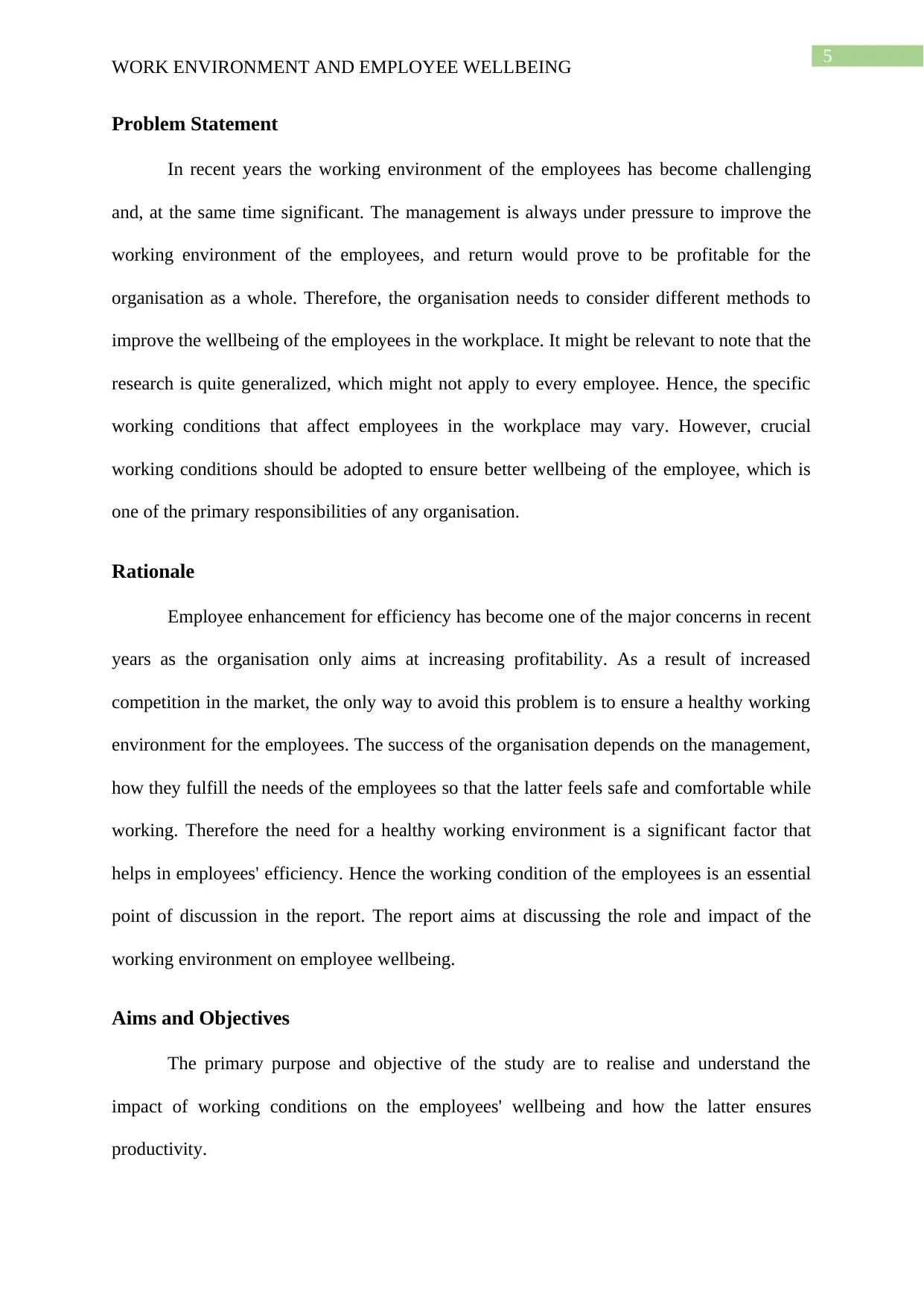
5
WORK ENVIRONMENT AND EMPLOYEE WELLBEING
Problem Statement
In recent years the working environment of the employees has become challenging
and, at the same time significant. The management is always under pressure to improve the
working environment of the employees, and return would prove to be profitable for the
organisation as a whole. Therefore, the organisation needs to consider different methods to
improve the wellbeing of the employees in the workplace. It might be relevant to note that the
research is quite generalized, which might not apply to every employee. Hence, the specific
working conditions that affect employees in the workplace may vary. However, crucial
working conditions should be adopted to ensure better wellbeing of the employee, which is
one of the primary responsibilities of any organisation.
Rationale
Employee enhancement for efficiency has become one of the major concerns in recent
years as the organisation only aims at increasing profitability. As a result of increased
competition in the market, the only way to avoid this problem is to ensure a healthy working
environment for the employees. The success of the organisation depends on the management,
how they fulfill the needs of the employees so that the latter feels safe and comfortable while
working. Therefore the need for a healthy working environment is a significant factor that
helps in employees' efficiency. Hence the working condition of the employees is an essential
point of discussion in the report. The report aims at discussing the role and impact of the
working environment on employee wellbeing.
Aims and Objectives
The primary purpose and objective of the study are to realise and understand the
impact of working conditions on the employees' wellbeing and how the latter ensures
productivity.
WORK ENVIRONMENT AND EMPLOYEE WELLBEING
Problem Statement
In recent years the working environment of the employees has become challenging
and, at the same time significant. The management is always under pressure to improve the
working environment of the employees, and return would prove to be profitable for the
organisation as a whole. Therefore, the organisation needs to consider different methods to
improve the wellbeing of the employees in the workplace. It might be relevant to note that the
research is quite generalized, which might not apply to every employee. Hence, the specific
working conditions that affect employees in the workplace may vary. However, crucial
working conditions should be adopted to ensure better wellbeing of the employee, which is
one of the primary responsibilities of any organisation.
Rationale
Employee enhancement for efficiency has become one of the major concerns in recent
years as the organisation only aims at increasing profitability. As a result of increased
competition in the market, the only way to avoid this problem is to ensure a healthy working
environment for the employees. The success of the organisation depends on the management,
how they fulfill the needs of the employees so that the latter feels safe and comfortable while
working. Therefore the need for a healthy working environment is a significant factor that
helps in employees' efficiency. Hence the working condition of the employees is an essential
point of discussion in the report. The report aims at discussing the role and impact of the
working environment on employee wellbeing.
Aims and Objectives
The primary purpose and objective of the study are to realise and understand the
impact of working conditions on the employees' wellbeing and how the latter ensures
productivity.
⊘ This is a preview!⊘
Do you want full access?
Subscribe today to unlock all pages.

Trusted by 1+ million students worldwide
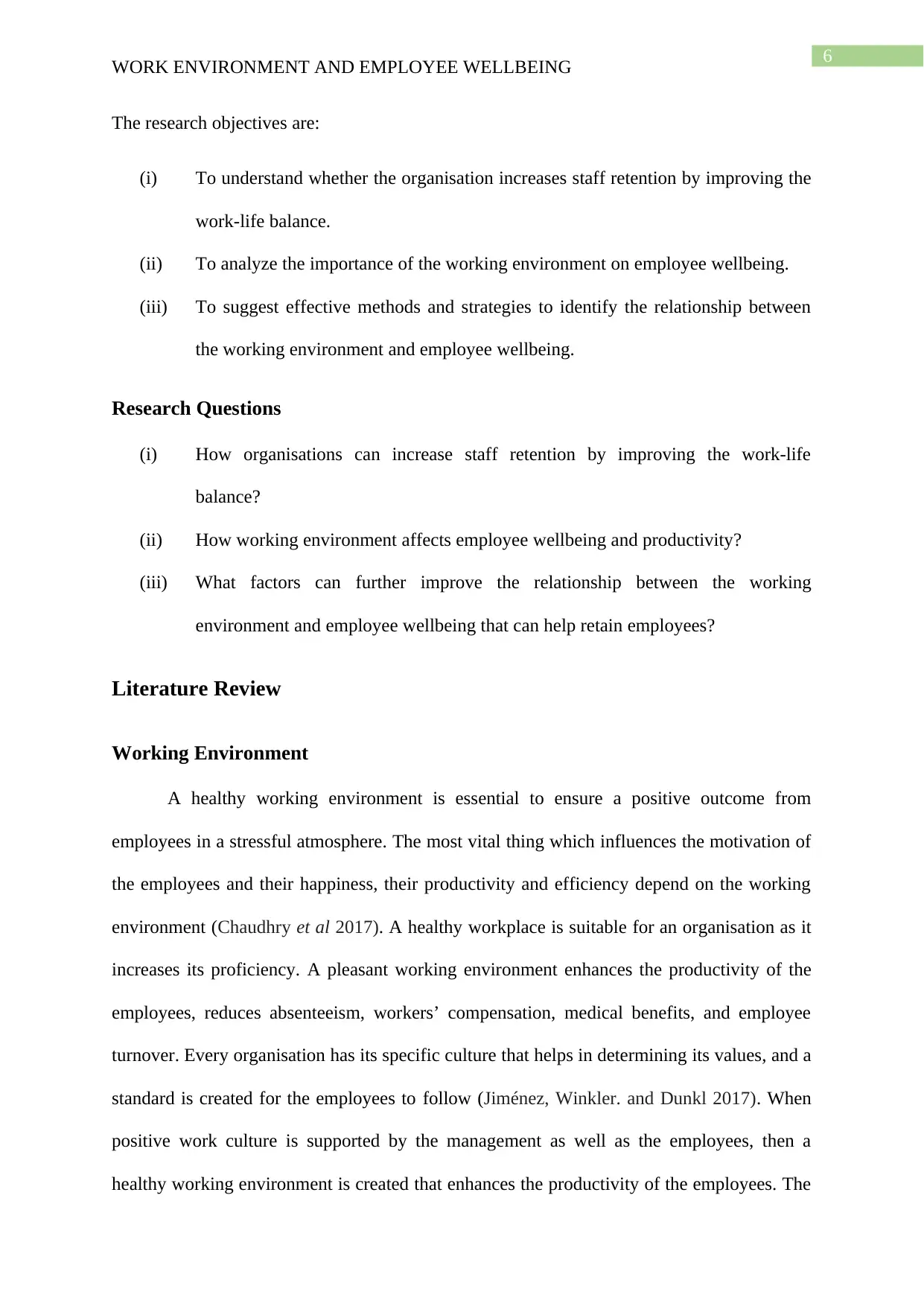
6
WORK ENVIRONMENT AND EMPLOYEE WELLBEING
The research objectives are:
(i) To understand whether the organisation increases staff retention by improving the
work-life balance.
(ii) To analyze the importance of the working environment on employee wellbeing.
(iii) To suggest effective methods and strategies to identify the relationship between
the working environment and employee wellbeing.
Research Questions
(i) How organisations can increase staff retention by improving the work-life
balance?
(ii) How working environment affects employee wellbeing and productivity?
(iii) What factors can further improve the relationship between the working
environment and employee wellbeing that can help retain employees?
Literature Review
Working Environment
A healthy working environment is essential to ensure a positive outcome from
employees in a stressful atmosphere. The most vital thing which influences the motivation of
the employees and their happiness, their productivity and efficiency depend on the working
environment (Chaudhry et al 2017). A healthy workplace is suitable for an organisation as it
increases its proficiency. A pleasant working environment enhances the productivity of the
employees, reduces absenteeism, workers’ compensation, medical benefits, and employee
turnover. Every organisation has its specific culture that helps in determining its values, and a
standard is created for the employees to follow (Jiménez, Winkler. and Dunkl 2017). When
positive work culture is supported by the management as well as the employees, then a
healthy working environment is created that enhances the productivity of the employees. The
WORK ENVIRONMENT AND EMPLOYEE WELLBEING
The research objectives are:
(i) To understand whether the organisation increases staff retention by improving the
work-life balance.
(ii) To analyze the importance of the working environment on employee wellbeing.
(iii) To suggest effective methods and strategies to identify the relationship between
the working environment and employee wellbeing.
Research Questions
(i) How organisations can increase staff retention by improving the work-life
balance?
(ii) How working environment affects employee wellbeing and productivity?
(iii) What factors can further improve the relationship between the working
environment and employee wellbeing that can help retain employees?
Literature Review
Working Environment
A healthy working environment is essential to ensure a positive outcome from
employees in a stressful atmosphere. The most vital thing which influences the motivation of
the employees and their happiness, their productivity and efficiency depend on the working
environment (Chaudhry et al 2017). A healthy workplace is suitable for an organisation as it
increases its proficiency. A pleasant working environment enhances the productivity of the
employees, reduces absenteeism, workers’ compensation, medical benefits, and employee
turnover. Every organisation has its specific culture that helps in determining its values, and a
standard is created for the employees to follow (Jiménez, Winkler. and Dunkl 2017). When
positive work culture is supported by the management as well as the employees, then a
healthy working environment is created that enhances the productivity of the employees. The
Paraphrase This Document
Need a fresh take? Get an instant paraphrase of this document with our AI Paraphraser
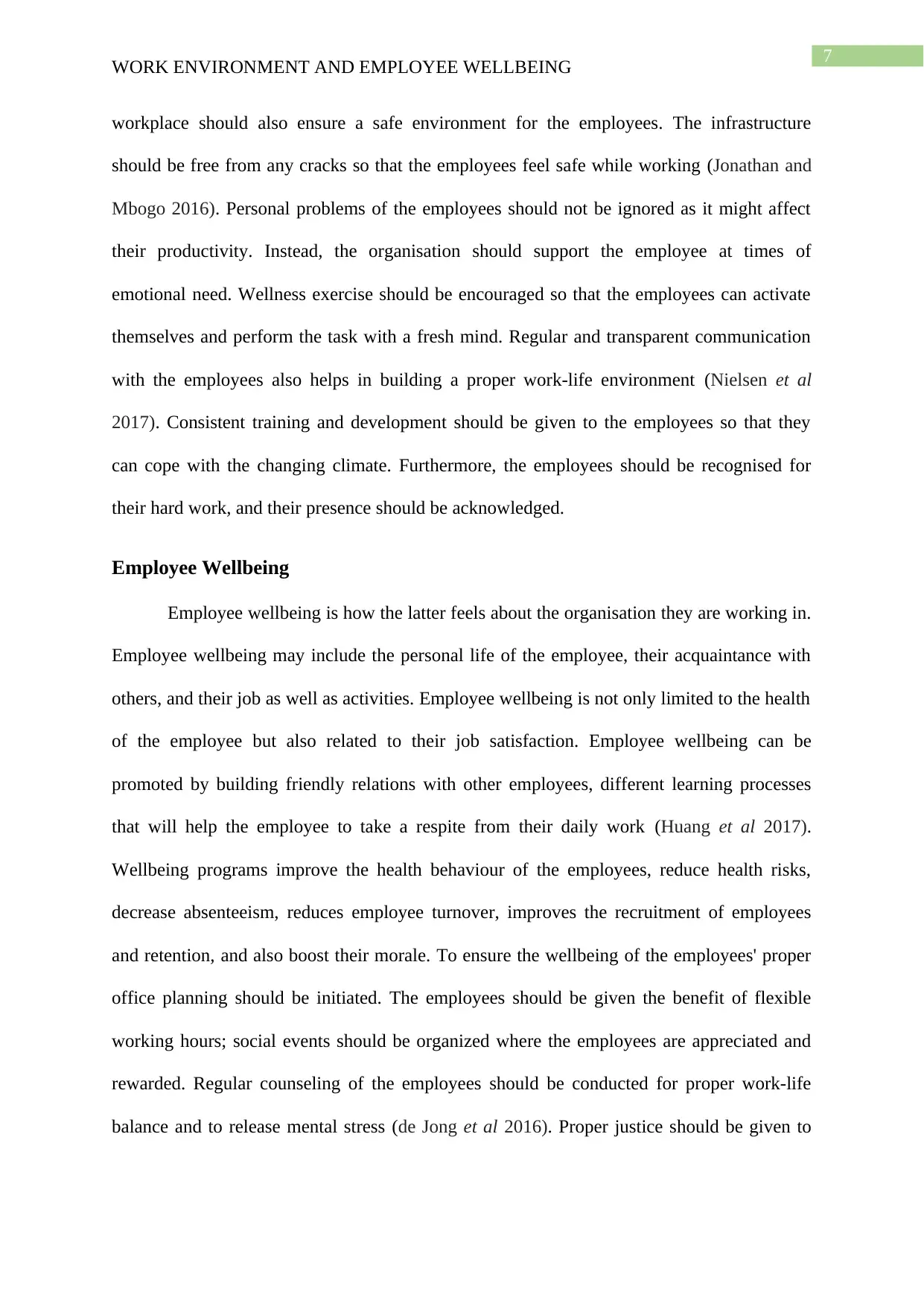
7
WORK ENVIRONMENT AND EMPLOYEE WELLBEING
workplace should also ensure a safe environment for the employees. The infrastructure
should be free from any cracks so that the employees feel safe while working (Jonathan and
Mbogo 2016). Personal problems of the employees should not be ignored as it might affect
their productivity. Instead, the organisation should support the employee at times of
emotional need. Wellness exercise should be encouraged so that the employees can activate
themselves and perform the task with a fresh mind. Regular and transparent communication
with the employees also helps in building a proper work-life environment (Nielsen et al
2017). Consistent training and development should be given to the employees so that they
can cope with the changing climate. Furthermore, the employees should be recognised for
their hard work, and their presence should be acknowledged.
Employee Wellbeing
Employee wellbeing is how the latter feels about the organisation they are working in.
Employee wellbeing may include the personal life of the employee, their acquaintance with
others, and their job as well as activities. Employee wellbeing is not only limited to the health
of the employee but also related to their job satisfaction. Employee wellbeing can be
promoted by building friendly relations with other employees, different learning processes
that will help the employee to take a respite from their daily work (Huang et al 2017).
Wellbeing programs improve the health behaviour of the employees, reduce health risks,
decrease absenteeism, reduces employee turnover, improves the recruitment of employees
and retention, and also boost their morale. To ensure the wellbeing of the employees' proper
office planning should be initiated. The employees should be given the benefit of flexible
working hours; social events should be organized where the employees are appreciated and
rewarded. Regular counseling of the employees should be conducted for proper work-life
balance and to release mental stress (de Jong et al 2016). Proper justice should be given to
WORK ENVIRONMENT AND EMPLOYEE WELLBEING
workplace should also ensure a safe environment for the employees. The infrastructure
should be free from any cracks so that the employees feel safe while working (Jonathan and
Mbogo 2016). Personal problems of the employees should not be ignored as it might affect
their productivity. Instead, the organisation should support the employee at times of
emotional need. Wellness exercise should be encouraged so that the employees can activate
themselves and perform the task with a fresh mind. Regular and transparent communication
with the employees also helps in building a proper work-life environment (Nielsen et al
2017). Consistent training and development should be given to the employees so that they
can cope with the changing climate. Furthermore, the employees should be recognised for
their hard work, and their presence should be acknowledged.
Employee Wellbeing
Employee wellbeing is how the latter feels about the organisation they are working in.
Employee wellbeing may include the personal life of the employee, their acquaintance with
others, and their job as well as activities. Employee wellbeing is not only limited to the health
of the employee but also related to their job satisfaction. Employee wellbeing can be
promoted by building friendly relations with other employees, different learning processes
that will help the employee to take a respite from their daily work (Huang et al 2017).
Wellbeing programs improve the health behaviour of the employees, reduce health risks,
decrease absenteeism, reduces employee turnover, improves the recruitment of employees
and retention, and also boost their morale. To ensure the wellbeing of the employees' proper
office planning should be initiated. The employees should be given the benefit of flexible
working hours; social events should be organized where the employees are appreciated and
rewarded. Regular counseling of the employees should be conducted for proper work-life
balance and to release mental stress (de Jong et al 2016). Proper justice should be given to
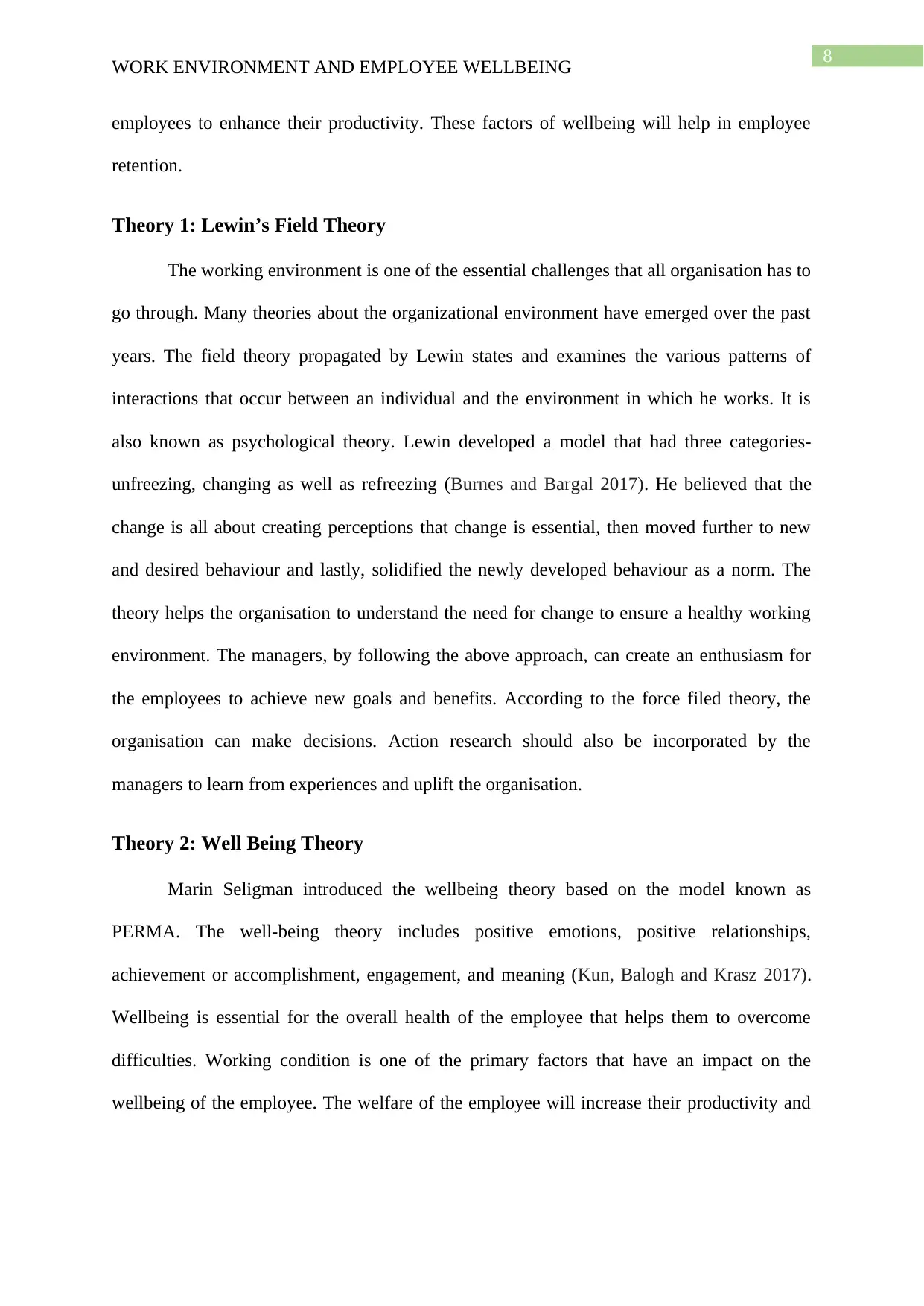
8
WORK ENVIRONMENT AND EMPLOYEE WELLBEING
employees to enhance their productivity. These factors of wellbeing will help in employee
retention.
Theory 1: Lewin’s Field Theory
The working environment is one of the essential challenges that all organisation has to
go through. Many theories about the organizational environment have emerged over the past
years. The field theory propagated by Lewin states and examines the various patterns of
interactions that occur between an individual and the environment in which he works. It is
also known as psychological theory. Lewin developed a model that had three categories-
unfreezing, changing as well as refreezing (Burnes and Bargal 2017). He believed that the
change is all about creating perceptions that change is essential, then moved further to new
and desired behaviour and lastly, solidified the newly developed behaviour as a norm. The
theory helps the organisation to understand the need for change to ensure a healthy working
environment. The managers, by following the above approach, can create an enthusiasm for
the employees to achieve new goals and benefits. According to the force filed theory, the
organisation can make decisions. Action research should also be incorporated by the
managers to learn from experiences and uplift the organisation.
Theory 2: Well Being Theory
Marin Seligman introduced the wellbeing theory based on the model known as
PERMA. The well-being theory includes positive emotions, positive relationships,
achievement or accomplishment, engagement, and meaning (Kun, Balogh and Krasz 2017).
Wellbeing is essential for the overall health of the employee that helps them to overcome
difficulties. Working condition is one of the primary factors that have an impact on the
wellbeing of the employee. The welfare of the employee will increase their productivity and
WORK ENVIRONMENT AND EMPLOYEE WELLBEING
employees to enhance their productivity. These factors of wellbeing will help in employee
retention.
Theory 1: Lewin’s Field Theory
The working environment is one of the essential challenges that all organisation has to
go through. Many theories about the organizational environment have emerged over the past
years. The field theory propagated by Lewin states and examines the various patterns of
interactions that occur between an individual and the environment in which he works. It is
also known as psychological theory. Lewin developed a model that had three categories-
unfreezing, changing as well as refreezing (Burnes and Bargal 2017). He believed that the
change is all about creating perceptions that change is essential, then moved further to new
and desired behaviour and lastly, solidified the newly developed behaviour as a norm. The
theory helps the organisation to understand the need for change to ensure a healthy working
environment. The managers, by following the above approach, can create an enthusiasm for
the employees to achieve new goals and benefits. According to the force filed theory, the
organisation can make decisions. Action research should also be incorporated by the
managers to learn from experiences and uplift the organisation.
Theory 2: Well Being Theory
Marin Seligman introduced the wellbeing theory based on the model known as
PERMA. The well-being theory includes positive emotions, positive relationships,
achievement or accomplishment, engagement, and meaning (Kun, Balogh and Krasz 2017).
Wellbeing is essential for the overall health of the employee that helps them to overcome
difficulties. Working condition is one of the primary factors that have an impact on the
wellbeing of the employee. The welfare of the employee will increase their productivity and
⊘ This is a preview!⊘
Do you want full access?
Subscribe today to unlock all pages.

Trusted by 1+ million students worldwide
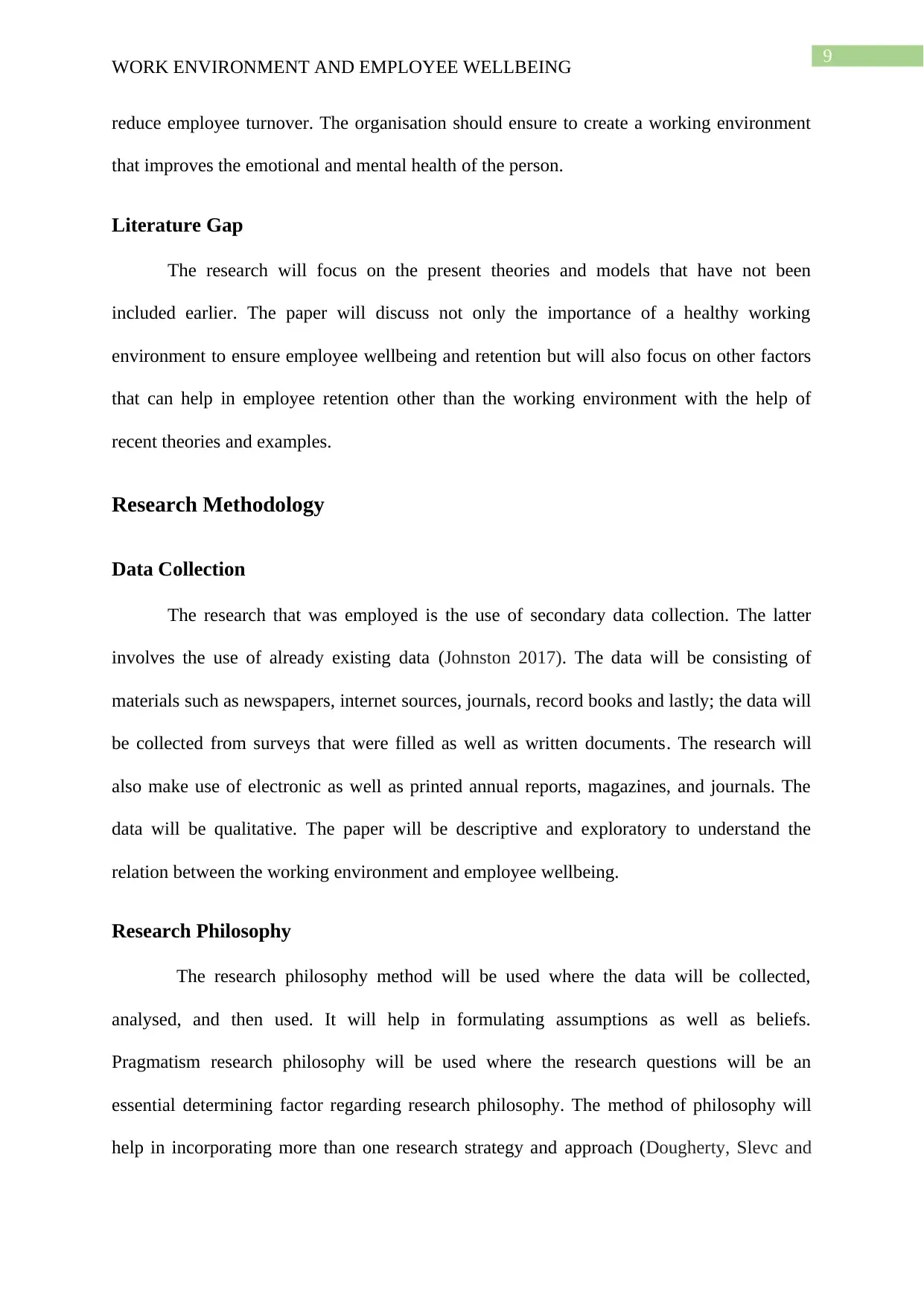
9
WORK ENVIRONMENT AND EMPLOYEE WELLBEING
reduce employee turnover. The organisation should ensure to create a working environment
that improves the emotional and mental health of the person.
Literature Gap
The research will focus on the present theories and models that have not been
included earlier. The paper will discuss not only the importance of a healthy working
environment to ensure employee wellbeing and retention but will also focus on other factors
that can help in employee retention other than the working environment with the help of
recent theories and examples.
Research Methodology
Data Collection
The research that was employed is the use of secondary data collection. The latter
involves the use of already existing data (Johnston 2017). The data will be consisting of
materials such as newspapers, internet sources, journals, record books and lastly; the data will
be collected from surveys that were filled as well as written documents. The research will
also make use of electronic as well as printed annual reports, magazines, and journals. The
data will be qualitative. The paper will be descriptive and exploratory to understand the
relation between the working environment and employee wellbeing.
Research Philosophy
The research philosophy method will be used where the data will be collected,
analysed, and then used. It will help in formulating assumptions as well as beliefs.
Pragmatism research philosophy will be used where the research questions will be an
essential determining factor regarding research philosophy. The method of philosophy will
help in incorporating more than one research strategy and approach (Dougherty, Slevc and
WORK ENVIRONMENT AND EMPLOYEE WELLBEING
reduce employee turnover. The organisation should ensure to create a working environment
that improves the emotional and mental health of the person.
Literature Gap
The research will focus on the present theories and models that have not been
included earlier. The paper will discuss not only the importance of a healthy working
environment to ensure employee wellbeing and retention but will also focus on other factors
that can help in employee retention other than the working environment with the help of
recent theories and examples.
Research Methodology
Data Collection
The research that was employed is the use of secondary data collection. The latter
involves the use of already existing data (Johnston 2017). The data will be consisting of
materials such as newspapers, internet sources, journals, record books and lastly; the data will
be collected from surveys that were filled as well as written documents. The research will
also make use of electronic as well as printed annual reports, magazines, and journals. The
data will be qualitative. The paper will be descriptive and exploratory to understand the
relation between the working environment and employee wellbeing.
Research Philosophy
The research philosophy method will be used where the data will be collected,
analysed, and then used. It will help in formulating assumptions as well as beliefs.
Pragmatism research philosophy will be used where the research questions will be an
essential determining factor regarding research philosophy. The method of philosophy will
help in incorporating more than one research strategy and approach (Dougherty, Slevc and
Paraphrase This Document
Need a fresh take? Get an instant paraphrase of this document with our AI Paraphraser
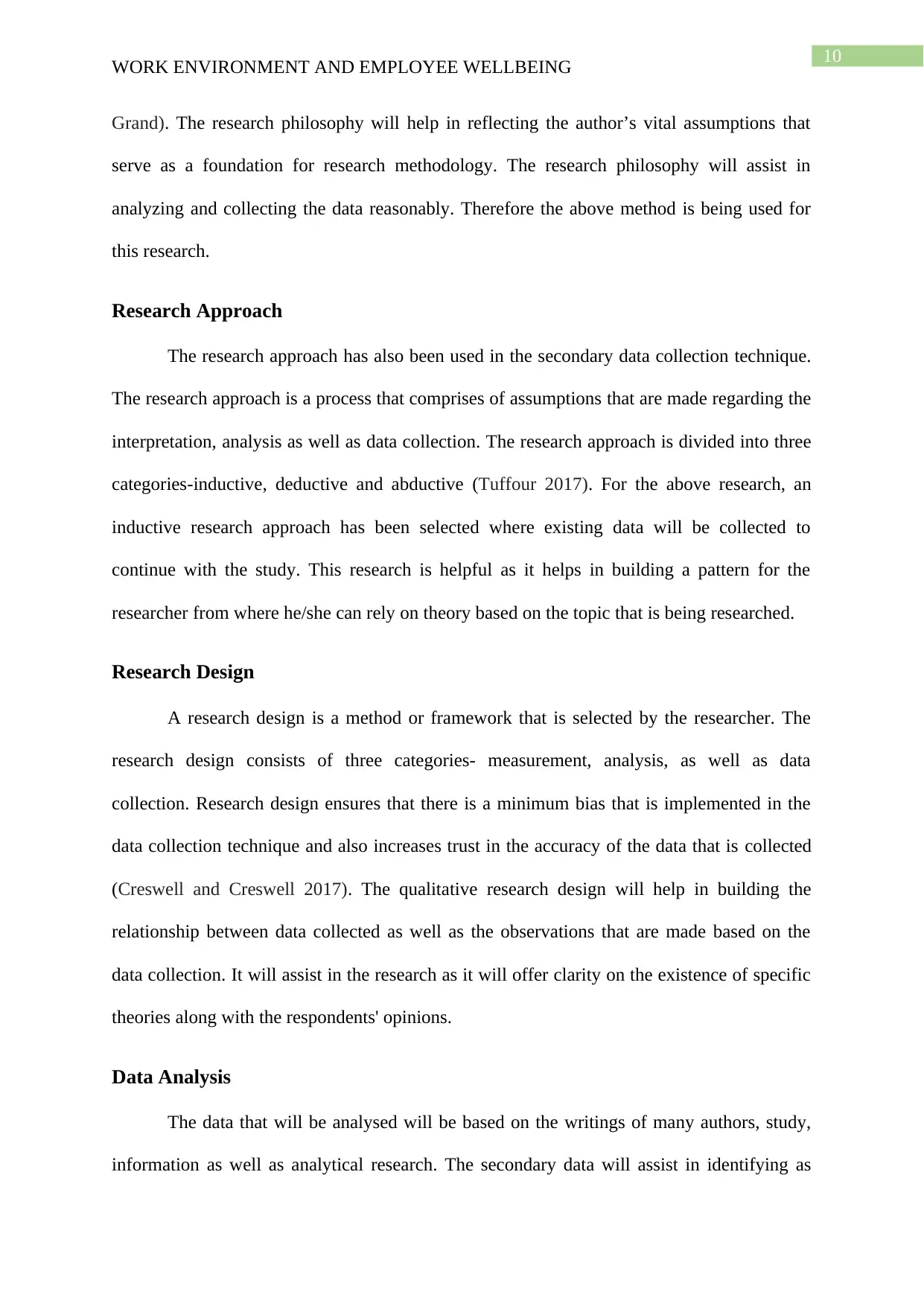
10
WORK ENVIRONMENT AND EMPLOYEE WELLBEING
Grand). The research philosophy will help in reflecting the author’s vital assumptions that
serve as a foundation for research methodology. The research philosophy will assist in
analyzing and collecting the data reasonably. Therefore the above method is being used for
this research.
Research Approach
The research approach has also been used in the secondary data collection technique.
The research approach is a process that comprises of assumptions that are made regarding the
interpretation, analysis as well as data collection. The research approach is divided into three
categories-inductive, deductive and abductive (Tuffour 2017). For the above research, an
inductive research approach has been selected where existing data will be collected to
continue with the study. This research is helpful as it helps in building a pattern for the
researcher from where he/she can rely on theory based on the topic that is being researched.
Research Design
A research design is a method or framework that is selected by the researcher. The
research design consists of three categories- measurement, analysis, as well as data
collection. Research design ensures that there is a minimum bias that is implemented in the
data collection technique and also increases trust in the accuracy of the data that is collected
(Creswell and Creswell 2017). The qualitative research design will help in building the
relationship between data collected as well as the observations that are made based on the
data collection. It will assist in the research as it will offer clarity on the existence of specific
theories along with the respondents' opinions.
Data Analysis
The data that will be analysed will be based on the writings of many authors, study,
information as well as analytical research. The secondary data will assist in identifying as
WORK ENVIRONMENT AND EMPLOYEE WELLBEING
Grand). The research philosophy will help in reflecting the author’s vital assumptions that
serve as a foundation for research methodology. The research philosophy will assist in
analyzing and collecting the data reasonably. Therefore the above method is being used for
this research.
Research Approach
The research approach has also been used in the secondary data collection technique.
The research approach is a process that comprises of assumptions that are made regarding the
interpretation, analysis as well as data collection. The research approach is divided into three
categories-inductive, deductive and abductive (Tuffour 2017). For the above research, an
inductive research approach has been selected where existing data will be collected to
continue with the study. This research is helpful as it helps in building a pattern for the
researcher from where he/she can rely on theory based on the topic that is being researched.
Research Design
A research design is a method or framework that is selected by the researcher. The
research design consists of three categories- measurement, analysis, as well as data
collection. Research design ensures that there is a minimum bias that is implemented in the
data collection technique and also increases trust in the accuracy of the data that is collected
(Creswell and Creswell 2017). The qualitative research design will help in building the
relationship between data collected as well as the observations that are made based on the
data collection. It will assist in the research as it will offer clarity on the existence of specific
theories along with the respondents' opinions.
Data Analysis
The data that will be analysed will be based on the writings of many authors, study,
information as well as analytical research. The secondary data will assist in identifying as
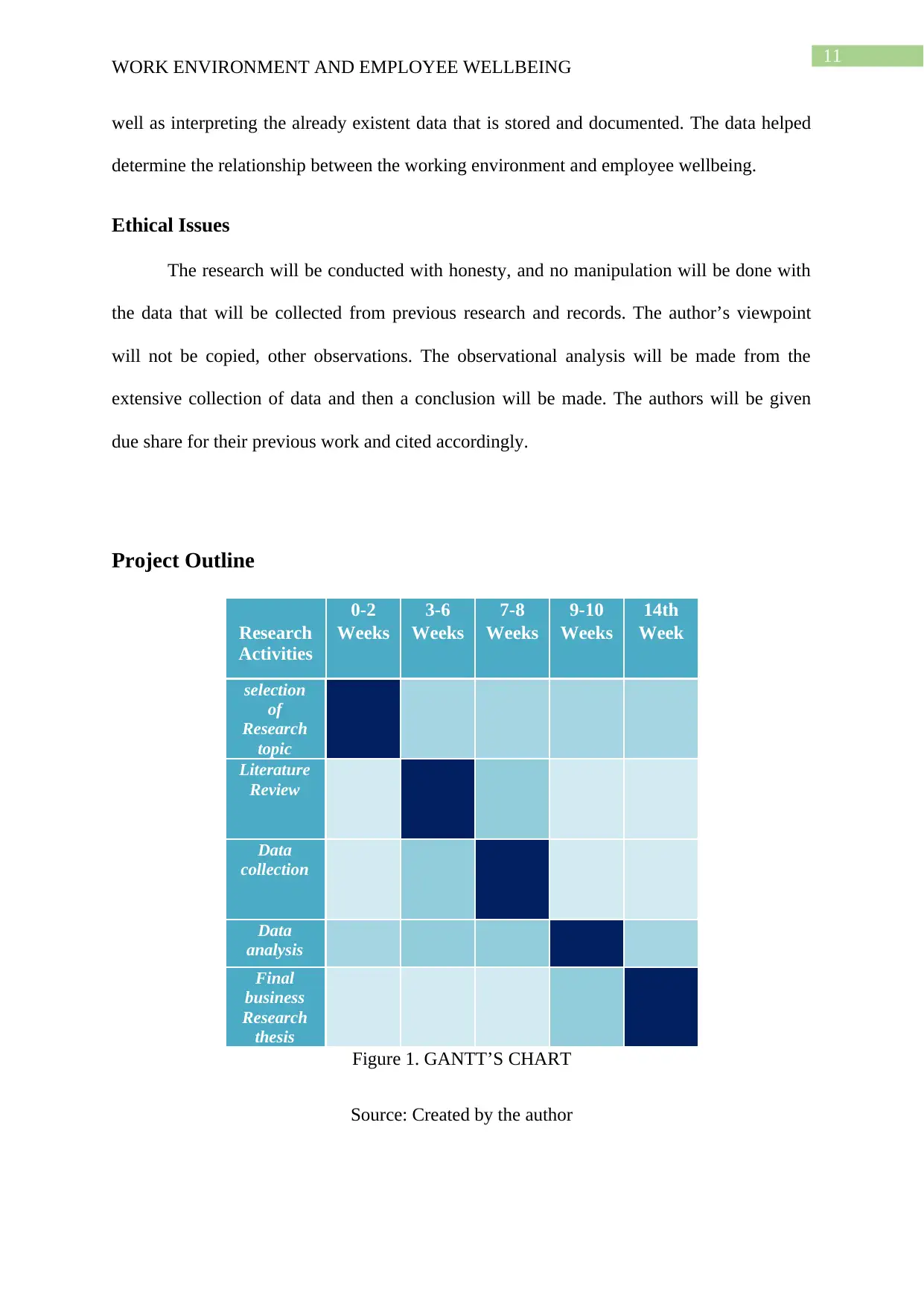
11
WORK ENVIRONMENT AND EMPLOYEE WELLBEING
well as interpreting the already existent data that is stored and documented. The data helped
determine the relationship between the working environment and employee wellbeing.
Ethical Issues
The research will be conducted with honesty, and no manipulation will be done with
the data that will be collected from previous research and records. The author’s viewpoint
will not be copied, other observations. The observational analysis will be made from the
extensive collection of data and then a conclusion will be made. The authors will be given
due share for their previous work and cited accordingly.
Project Outline
0-2 3-6 7-8 9-10 14th
Research
Activities
Weeks Weeks Weeks Weeks Week
selection
of
Research
topic
Literature
Review
Data
collection
Data
analysis
Final
business
Research
thesis
Figure 1. GANTT’S CHART
Source: Created by the author
WORK ENVIRONMENT AND EMPLOYEE WELLBEING
well as interpreting the already existent data that is stored and documented. The data helped
determine the relationship between the working environment and employee wellbeing.
Ethical Issues
The research will be conducted with honesty, and no manipulation will be done with
the data that will be collected from previous research and records. The author’s viewpoint
will not be copied, other observations. The observational analysis will be made from the
extensive collection of data and then a conclusion will be made. The authors will be given
due share for their previous work and cited accordingly.
Project Outline
0-2 3-6 7-8 9-10 14th
Research
Activities
Weeks Weeks Weeks Weeks Week
selection
of
Research
topic
Literature
Review
Data
collection
Data
analysis
Final
business
Research
thesis
Figure 1. GANTT’S CHART
Source: Created by the author
⊘ This is a preview!⊘
Do you want full access?
Subscribe today to unlock all pages.

Trusted by 1+ million students worldwide
1 out of 15
Related Documents
Your All-in-One AI-Powered Toolkit for Academic Success.
+13062052269
info@desklib.com
Available 24*7 on WhatsApp / Email
![[object Object]](/_next/static/media/star-bottom.7253800d.svg)
Unlock your academic potential
Copyright © 2020–2025 A2Z Services. All Rights Reserved. Developed and managed by ZUCOL.





